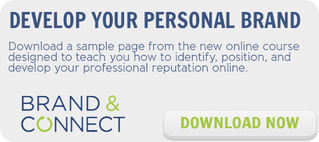"Who are you, and why should I care?"
That simple question is at the crux of the challenge salespeople face when prospecting. The advice used to be to perfect your elevator pitch. Today we don’t meet prospects on elevators; we meet them online. And specifically, the great business-oriented platform for meeting people is LinkedIn. So what you need to perfect now is your online personal branding. That's your LinkedIn presence.
If you’re like most people, you created your LinkedIn profile by copying and pasting from your most recent resume. Ten years ago, when LinkedIn was just a gigantic, virtual job fair, that would have been appropriate. But it’s vastly more today: When someone wants to know more about you, they look online. Google search results dispatch them quickly to LinkedIn—if the person didn’t automatically start there.
Who you are on LinkedIn is who you are. It’s your personal brand.
Your personal brand is not your resume.

The first problem with so many LinkedIn profiles is that they read like what they are—material copied and pasted from a job resume. That’s boring. But it’s worse than boring. What you would say to a prospective employer is hardly identical to what you would say to a prospective client, right? In fact, what you’d say to a prospective employer might be poison if it popped up on the screen of a prospect with whom you’re eager to meet.
But your resume may contain some juicy information that needs to brought out and highlighted. Forget about the job title. Look at what you accomplished in each role and describe those accomplishments in terms of how they impacted your clients. Write a sentence or two that demonstrates how you offered value; tell a story that your current prospects would find interesting, promising, and potentially valuable. Even if they weren’t all sales roles, you still may have demonstrated strategic thinking, delivered exceptional results, or identified and solved needs and challenges.
Your personal brand is not your company’s brand.

The next temptation is to write too much about your company. Your company’s talking points are all well and good, but they’re not your talking points. That prospect you’re longing to see is going to Google your company, too. She’s going to read the company’s pitch, the company’s positioning, the company’s points. What will she conclude if she then checks you out on LinkedIn and sees the very same thing? The only conclusion is that you are nothing more than a megaphone for whatever the company wants to chat up. That’s the exact opposite of the image you wish to portray—that you’re personally invested in your clients’ success and that you personally add value.
Your personal brand is not what you sell.

The products and services you represent are important. You couldn’t deliver a solution without them. But they’re not you, either. Your personal brand should have nothing to do with the attributes and advantages of what you sell. Let the prospect read about that somewhere else (rest assured they’ll look up review sites to get the real story, anyway). You sell solutions to client problems and plans that help nail their opportunities. How do you build those solutions? How is working with you different than working with someone else who sells the same stuff? Answer those questions and you’re describing your personal brand.
Your personal brand is information that lowers the risk of meeting with you.

Yes, meeting with you is risky. The prospect is probably not concerned that you’ll attack him, but based on other salespeople he’s met with over the years, he’s real concerned that the meeting will waste his time. Sharing the value you offer prospective clients allows them to learn what it would be like to work with you, before meeting you. Knowing who you are and how you do business will reduce the apparent risk—and increase the likelihood you’ll get that appointment you seek.
Now look at your LinkedIn profile. Is it your job application? Is it al about your company? Does it crow about what you sell? Or is it you? If it’s not you, or if it fails to describe how you personally deliver value, you know what you need to do next.



